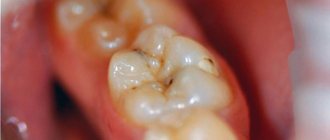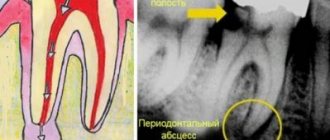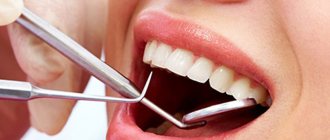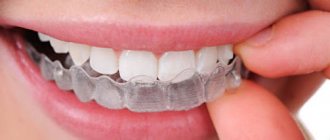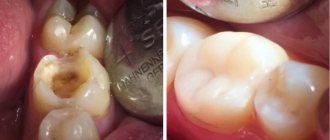Photopolymers for teeth are an innovative achievement in the field of dentistry. A new method appeared relatively recently and quickly became popular due to the low price of photopolymer dental restoration with a large number of advantages. With the help of photopolymers, tooth restoration is carried out in case of various damage to the enamel, the presence of cracks or incorrect location, for color correction, for filling or partial restoration of the shape of the tooth. Sign up for a consultation with specialists at the Omnident clinic in Moscow, and we will restore the beauty and health of your teeth using photopolymer materials.
Aesthetic dental restoration
Aesthetic dental restoration - one of the most dynamically developing areas of modern dentistry - allows you to correct any external defects of teeth, including congenital ones.
And more and more often, patients come to clinics not with a complaint of pain, but with a request to get rid of dental defects. In our modern world, a healthy and beautiful smile is an integral attribute of a modern person. But what to do if you are not satisfied with the appearance of your teeth: their color, shape? Or if a piece of your tooth breaks off? Do you really need to put up with and hide these shortcomings all your life? Or will I have to install crowns?
Aesthetic dental restoration in Moscow
Call
Artistic restoration of teeth is the recreation of the shape and functional effectiveness of damaged teeth in the absence of the possibility or ineffectiveness of solving the problem using filling. Tooth restoration can be direct or indirect. Direct dental restoration is carried out directly in the oral cavity by building on a pin and adhesively attaching special composite materials or photopolymers to the tooth tissue and giving them the required shape. In the indirect method of dental restoration, veneers, bridges and crowns are used. If you are interested in where to undergo complete aesthetic restoration of damaged teeth in Moscow at an affordable price, contact the specialists of our dental clinic.
Dental restoration process
Direct restoration of the anterior and posterior teeth is carried out in one visit to the doctor. However, it should be taken into account that the time required to perform restoration varies individually and depends on the amount of work and the number of teeth being restored. Generally, a basic dental procedure takes 30 to 40 minutes. If necessary, the dental treatment procedure takes place in one or several preliminary appointments.
Direct dental restoration takes place in several stages:
- A set of preparation measures - hygienic cleaning of the oral cavity, determination of the natural color of tooth enamel and selection of the appropriate color of the photopolymer composite.
- If necessary, administer local anesthesia.
- Removal of affected areas of the tooth due to caries, treatment, replacement of old fillings.
- Installation of a pin (in case of missing more than half of the tooth).
- The procedure itself for restoring teeth with a composite material by layer-by-layer application.
- The final stage is modeling the final shape for the correct bite, eliminating irregularities and polishing.
Advantages and disadvantages of artistic dental restoration.
The advantage of direct dental restoration is an absolutely accurate reconstruction of the shape in one visit to the doctor, the possibility of restoration without anesthesia and long-term wearing of veneers and other structures. Disadvantages include the likelihood of breakage under heavy chewing load and discoloration over time. On average, with artistic restoration of a tooth, it will last another 8-12 years; if the doctor’s recommendations are fully followed, then up to 20 years.
Dental restoration in Moscow: indications and contraindications.
Aesthetic dental restoration is applicable in the following cases:
- Violations of the integrity of the frontal, lateral and other surfaces;
- Enamel damage;
- Skolov;
- For pulpless teeth;
- For cracks in teeth;
- Breakage of 1 or more teeth;
- Curvature of teeth, malocclusion and other disorders when aesthetic dental restoration is no longer possible.
Artistic restoration of teeth in Moscow is contraindicated in cases of bruxism, rapid development of caries, inaccessibility of the source of inflammation, difficulty in isolating the tooth, and in some other cases. Where the tooth is located is also important.
Experienced dentists at our dentistry in Moscow will perform aesthetic dental restoration procedures at a cost affordable to everyone. If you are interested in how much tooth restoration costs, check out the Prices section or call Clearstom Dentistry for a free consultation by phone or make an appointment!
Restoration with photopolymers (composite materials)
Photopolymers
– these are light-curing liquid composite materials, which consist of an organic matrix and filler, hardening under the influence of ultraviolet radiation. The quality of these materials will depend on the size and amount of filler used. For example, to restore the integrity of a tooth, hybrid composites with small particles are used, and large ones are used for filling.
Effective restoration of tooth enamel using photopolymer materials is one of the most reliable and aesthetic areas in dentistry today. Using photopolymers, you can either install a high-quality filling on a tooth, cure caries, or, if part of a tooth is missing, restore its shape to its original state. But modeling with photopolymers is only possible in the presence of tooth tissue.
Photopolymers are used if it is necessary to restore
:
- size, shape or color of the tooth;
- tooth enamel darkening;
- the entire crown, but only the root remains;
- tooth if chips or cracks occur.
Photopolymers are also used for tooth mobility or if there is a need to straighten the dentition.
Photopolymer filling (or as it is also called light filling) is not only very durable, but also has excellent aesthetic qualities. This type of composite reproduces the shape of the crown, and the filling can be given the desired natural color.
Indirect dental restoration
The orthopedic or indirect method involves the installation of replacement structures - veneers, lumineers, inlays, crowns. Essentially, this is microprosthetics.
Crowns are installed if most of the tooth has lost its integrity, and the task is not only to improve its aesthetics, but also to provide reliable protection from further destruction. Crowns are placed on both chewing and front teeth.
Aesthetic dental restoration involves the use of veneers and lumineers.
A veneer is a thin plate with a thickness of 0.2 mm, made of ceramics, glass ceramics, zirconium or other materials.
New technologies
The modern approach to restoring the functionality and aesthetics of teeth is radically different from that used several decades ago. New materials make it possible to achieve ideal beauty and long-term functioning of the dentition. Composite photopolymers are rightfully considered a breakthrough in dentistry. The latest materials for veneers and inlays are ideal for dental restoration. Modern pins provide high quality construction.
Advantages of using modern materials in dentistry:
- reliability and increased strength;
- high aesthetics of the result;
- the ability to solve problems of any complexity.
Advantages and disadvantages
The restoration method using composite materials has its positive and negative sides. Advantages of the technique:
- low cost of the method compared to orthopedic;
- speed of implementation - the procedure is carried out during one visit to the dentist, it is also possible to do several teeth in one visit;
- minimal fabric trimming;
- if there is a chip or channel work is required, correction can be carried out without removing the entire restoration composition;
- effective in the presence of chips, cracks or gaps between teeth.
It is also worth noting several disadvantages characteristic of this technique:
- shrinkage of the composite material, which requires grinding the edges of the restoration at least once a year;
- change in shade over time due to absorption of dyes;
- reduced impact resistance compared to ceramic structures;
- not recommended for use in patients with an installed pacemaker.
Basic principles for selecting a reconstruction method
- If tooth decay is insignificant and you do not want to pay a high price, composite materials are suitable.
- In case of serious tooth decay, you need a strong, reliable, albeit expensive design - a ceramic veneer or inlay.
- Serious destruction of the crown, but there is no room for a veneer or a cheaper option is needed - these are pin options.
- You need to restore one or more teeth permanently, efficiently and as aesthetically as possible - an implant will help.
- Fixed bridge prosthesis - this option is used to fill the space from the absence of one tooth.
The doctor at the clinic will suggest a specific solution to the problem after the examination. The patient needs to be informed about his habits and wishes, since this determines which method is suitable for the person.
Artistic restoration of chewing teeth
Indirect method. When the upper relief layer of a tooth is lost, doctors use linings made of ceramic material for restoration. They completely cover the surface of the tooth and do not allow decay and any harmful effects to spread. Direct method. The loss of part of a tooth is eliminated by recreating a fragment from a polymer material. The work happens faster than the indirect method and can take half an hour. Our specialists prescribe the desired treatment option only after a thorough diagnosis, determine the optimal method and do not offer unnecessary procedures.
In what cases will photopolymer restoration help?
The use of photopolymers when performing restorative procedures makes it possible to achieve great success in recreating damaged teeth. With the help of such materials you can change both shade and shape.
The main indications for restoration with photopolymers are as follows:
- all kinds of damage to tooth enamel;
- the need to correct the color and/or shape of the tooth;
- partial destruction of the dental unit;
- incorrect arrangement of dental units in a row;
- wide interdental gap.
It should be understood that there are also a number of contraindications. Their list is relatively small. Thus, the procedure is not recommended if the patient suffers from bruxism, severe gum inflammation, or is allergic to the restorative material used.
Advantages of using photopolymer materials
Photopolymers are composite materials widely used in dental practice. They replaced fast-hardening plastics, which were previously used in restoration.
Photopolymers have the form of a paste or flowing material, the hardening of which is carried out as a result of exposure to special lamps. At the moment, dentists most often use LED lamps, which do not overheat the tissues.
The advantages of using photocomposites are obvious:
- high strength of materials, which ensures the durability of the restoration;
- minimum shrinkage upon completion of polymerization of the composition;
- wear resistance of finished structures;
- ease of design modeling;
- a wide range of colors, so that the restored unit does not differ in shade from neighboring teeth;
- minimal treatment of the tooth surface during restoration;
- the ability to complete the procedure in just one session;
- the procedure is completely painless for the patient;
- lack of a long rehabilitation period after the procedure.
It is worth noting that another good reason why many patients choose photopolymer dental restoration is price. Dental composites are an affordable material, and therefore their use makes it possible to provide high-quality medical care to patients with the lowest income levels.
How is restoration performed?
Restoration using photopolymers is a multi-step process. It looks something like this:
- first, professional hygienic cleaning is performed - this improves the adhesion of the composites to the enamel, and also removes solid deposits, making it possible to correctly determine the color of the enamel;
- previously installed fillings are removed, if any;
- using a special scale, a shade is selected that is as close as possible to the natural shade of the patient’s enamel;
- anesthesia is performed (usually local), after which the affected tissue is removed;
- the working area is isolated from saliva using special latex wipes so that exposure to moisture does not change the characteristics of the composite;
- the enamel is treated with a degreasing and antimicrobial composition;
- composites are applied in layers - each layer is dried separately with a lamp;
- Finally, correction and polishing are performed.
Features of restoration of chewing teeth
When it is necessary to restore chewing units, reliability, comfort and proper distribution of the load when eating food come to the fore. In this case, direct composite dental restoration with photopolymers is used. Its advantage over conventional fillings:
- withstands increased loads;
- practically merges with natural enamel;
- no grinding of healthy tissue is required;
- low pain of the procedure;
- has a high degree of adherence to dentin.
With proper care and following the dentist’s recommendations, restoration of a chewing tooth with a composite material provides a guarantee period of wearing a filling of up to 5–6 years. The procedure is used to eliminate the consequences of caries, enamel hypoplasia, and, if necessary, to form the upper part of the crown while preserving the root.
Our prices
There are many options for restoring teeth. This means that patients of any income will be able to afford a beautiful smile, as well as restoration of the chewing ability of their teeth. Without an examination, you can only find out how much it costs to restore a tooth. The exact price is determined based on the complexity of the destruction and the general condition of the teeth and gums.
To find out the cost of complete restoration of hard dental tissues, schedule a consultation with our dentistry by calling.
| Code no. | Name of procedures | Unit of measurement | Cost, rub. |
| 303 | Treatment of medium caries (ultrasound, cavity formation) | 700,00 | |
| 305 | Placement of a light-composite filling (Esthet-X, Filtek) | 3 500,00 | |
| 312 | Veneer coating with repositioning of teeth (complex) | 1 unit | 9 500,00 |
| 314 | Artistic restoration (changes in shape and position) complex | 1 unit | 13 000,00 |
| 317 | Tooth restoration using a fiberglass pin and reinforced composite material (Sonicfil, Luxocor) | 5 500,00 |
* The prices indicated on the website are not a public offer. The exact cost of treatment can only be determined at an appointment with a doctor.
Prices for treatment in Moscow full price list
Share on social media networks:
Article Expert:
Razumenko Evgeniy Gennadievich
Chief physician and founder of the dental clinic. He has been working in aesthetic dentistry for many years, restoring teeth of any complexity with ceramic and composite restorations. Winner of competitions in aesthetic dentistry. Applies CAD/CAM technologies in prosthetics.
Work experience 22 years
